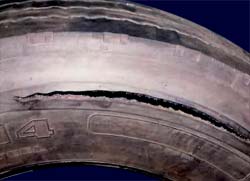Avoiding Potential Tread Separations & Zipper Ruptures
 What is a Zipper Rupture?A Zipper rupture is a circumferential rupture in the mid-sidewall of a steel-corded radial truck tire. These are particularly dangerous as they are unpredictable and often occur with little or no warning to alert the driver or tire service provider. They are frequently accompanied by a deafening blast with the explosive force of a pound of dynamite leaving a 10” to 36” zipper rupture in the sidewall. If this occurs while the tire and wheel are removed from the vehicle, but not yet in a cage, it can be life-threatening. Fortunately, it’s avoidable. How They OccurSteel-belted radial truck tires utilize steel cord sidewall plies to maintain the strength and integrity of the tire structure. They support the chamber, containing the air that carries the load. A puncture, leaking valve or any source of air migration (slow leaks) can lead to substantial, though not always apparent air loss. Tires that are under-inflated or overloaded will experience increased flexing and heat buildup. This produces severe bending of the steel cords. Consider that a truck tire rotates hundreds of times per mile and thousands of times per hour under a heavy load. According to ITRA (International Tire and Rubber Association), now TIA (Tire Industry Association), any tire known to have run at less than 80% of recommended air pressure could possibly have permanent steel cord fatigue. Quite often a pressure check reveals that one or more tires are substantially below this 80% threshold and could legally be considered to have run flat. This is the major cause of tread separations and zipper ruptures. New TiresThe ARA (American Retreader’s Association), now also known as TIA (Tire Industry Association), claims there are as many tread separations in new tires as in retreads. This is again attributable to air loss and air migration beneath the tread. The incidence of manufacturing defects in new and retread tires having been found to be the cause is generally low. Retread TiresThe repair, preparation and inspection of used casings are critical to the performance and longevity of the finished product. The smallest amount of air or improper adhesion between the cap and casing will expand as heat increases from deflection and road surface friction and can lead to delamination, tread separation and blowouts. PreventionThe number one cause of tread separation is porosity and air migration. Ultraseal Tirelife Extender/Sealer provides a uniform fluid/fiber coating that prevents air migration by sealing porosity and punctures as they occur. Additionally, Ultraseal draws heat from the tread and transfers it to the wheel and sidewall where it is more efficiently radiated to the outside. Heat and centrifugal force developed within the rotating tire will not pull Ultraseal from the area beneath the tread or degrade its composition. This is a proprietary process, unique to this product. For maximum benefit, install Ultraseal Tire Life Extender/Sealer into new or newly re-treaded tires prior to placing them into service. |





